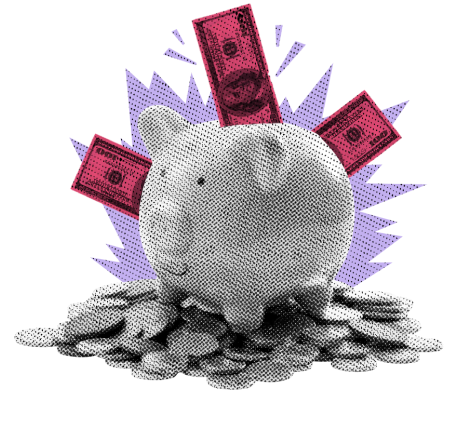
Confidence jumped with delayed tariffs. That might say more about the future than economists admit.
KEY TAKEAWAYS
- Consumption is the backbone of the U.S. economy, making up ⅔ of GDP.
- Consumers have historically spent through low confidence and tough conditions.
- Recent consumer confidence dipped sharply but just rebounded on tariff news.
- Consumption growth has slowed but remains above pre-pandemic trends.
- Tariff policy appears to be a key lever influencing sentiment—and future spending.
MY HOT TAKES
- The consumer is still the economy’s MVP—and I’m still the biggest fan.
- Weak confidence hasn’t meant weak spending in the past; don’t bet on that correlation now.
- Tariffs are more than just trade tools—they’re confidence killers.
- Consumption will eventually slow, but we haven’t seen the real trigger yet.
- The administration’s next move on tariffs might matter more than any Fed hike.
- You can quote me: “It is pretty clear that one of the leading indicators of consumer confidence is the administration’s tariff policies.”
Whose court is the ball in? I am not going to pretend that a famous New York basketball team, which I have followed through thick and mostly thin since I was in short pants, is not hanging on by a thread in the Eastern Conference Finals. Indeed, the ball is very much in their court as they head to game 4 being down 1 to 3 against Indianna. When it comes to the economy, the ball is in the court of Team Consumer.
My regular followers know that I am Team Consumer’s number one fan. As we say in New York, you can always find me “Spiked out courtside” at all the home games. I’ll leave it up to you to figure out what that means. My beloved regulars also know exactly why I am such a passionate fan. It’s simple. Consumption represents ⅔ of US GDP! What’s more, US consumers appear to be virtually unstoppable.
I remember back in 2017 and 2018 doing lots of presentations, and there were several slides dedicated to the probability of a recession. The economy had been expanding for quite a long time and there were plenty of headwinds, and those headwinds really picked up in mid 2018. Recession almost appeared to be inevitable. Unavoidable, even. Corporate earnings growth was declining, bumps from the 2017 tax package were in the rearview mirror, and GDP was about to hit a record expansion length. In finance, particularly in econometrics, we like to look at probabilities, and being that the expansion length was already such an outlier, chances of its extension began to appear unlikely. Here’s the punchline: Despite that each month as I revised my presentation I had to bump up the number of months of the expansion by one. In other words, the economy just kept growing against all odds. Companies were struggling, but consumers continued to click “buy now” and spend, spend, spend. Consumers alone kept the economy going.
Similarly, though it is not quite as clear, during the pandemic, it was the resiliency of US consumption that enabled the economy to recover so quickly. And it wasn’t just the economy, companies too boomed during the latter ⅔ of the pandemic era. Why? Who? What? Consumption, consumers, and they consumed–bigtime. Now, during that period, there was both unprecedented fiscal and monetary stimulus, but still, it is clear that those dollars were all being put to good use in consumption.
If we take a look at the two premier gauges of monthly consumer sentiment (Conference Board and University of Michigan) throughout those two periods, we see them rising steadily from the Global Financial Crisis and peaking in mid to late 2018. 2018 also saw the Fed raising interest rates. In the final months of the year, stocks declined under the weight of weak corporate earnings, Fed hikes, and the mounting trade war with China. In that final quarter we also saw confidence dip. The economy finally appeared to be ready to realize its statistical destiny and fall into a recession.
That would not happen, and do you know why? I painted a pretty clear numerical view of the year, but I neglected, intentionally, not to tell you that consumption was… booming. Despite elevated inflation, growing interest rates, declining markets, and falling sentiment, consumers were still consuming.
The pandemic would see a similar scenario, though nuanced differently. People were dying by the millions; store shelves were empty–most stores were closed. Consumer confidence hit record lows. Consumption declined at levels not seen since the Global Financial Crisis… … … BUT ONLY FOR ONE QUARTER. Consumer confidence would not mount a recovery until the following year, and it would never get back to its pre-pandemic highs. HOWEVER, consumption shot through the roof! Consumption growth had not grown at that pace since the early 1980s, and we were still in the midst of a pandemic. And, might I add, the global supply chain was completely busted. Who carried us through? Why, the consumer of course.
Ok, you got the picture, the consumer is important, and yes, I am fan #1. Now, consumption is not growing quite as fast as it was when it hit highs in early 2022 and you can blame that on the Fed’s aggressive rate-hiking, but it is still growing faster than it was pre-pandemic. Which brings us back to statistics and wondering when it will revert to the mean. In other words, when will consumption growth go back to its longer-run average, because if it does, it is likely that the US will experience a recession.
That all begs the question: what will it take to shake the consumer into pulling back on spending? Classically trained economists will tell you the price is everything. If prices get too high, consumers will simply stop spending. This can serve to tamp down inflation but also tank economic growth. You almost can’t have one without the other.
As one might guess, we are always on the hunt for that early indicator that the consumer may be ready to capitulate. A logical place to look would be, of course, consumer confidence. You all know my famous quote “confident consumers consume,” and they do. What if we look at it as a null hypothesis (academic friends are laughing 🧐🤣): H0: unconfident consumers don’t consume. If you have been following me up until now, you would know that at least since the Global Financial Crisis, we would reject the null hypothesis. In other words, more recently, weak consumer confidence may not be a strong predictor of recession.
In recent months we have seen a significant drop in consumer confidence, specifically since the President took office at the beginning of the year. We have also witnessed the emergence of a bear market. Though the S&P is technically still in the bear market, it is just about breakeven for the year, and the Nasdaq is now technically in a bull market (up more than 20% from lows). Consumption did indeed throw us a warning signal at the beginning of the year forcing many economists to sharpen their focus on the consumer.
The best guess by many would be that consumers are soon to stop spending money resulting from poor confidence and higher prices related to the administration's aggressive tariff policy. In this past earnings season, which is about to ground to a close this week, we have certainly heard anecdotal evidence from some companies that consumption is softening. However, will that follow through? Will confidence continue to decline to the point where consumers stop consuming? Will we finally accept the null hypothesis and end up in a recession?
Yesterday, The Conference Board released its Consumer Confidence Index which increased from 85.7 to 98.0 and topped estimates. Virtually all metrics that go into the index’s construction grew month over month. The reason for the large jump in confidence was the administrations delaying the so-called reciprocal tariffs that were announced on “liberation day.”
Now, I know that I just painted a scenario in which consumer confidence may not be a good leading indicator of consumption and recession, but I still believe it is an extremely important indicator. I do believe that confident consumers consume and that consumers are indeed pulling back a bit, though it has not yet shown up in the consumption numbers, which lag, and may have been distorted by front-load buying to avoid tariffs. That said, it is pretty clear that one of the leading indicators of confidence is the administration’s tariff policies. Pull back on tariffs, confidence increases, and consumption continues to thrive. In other words, the ball is really in the court of the administration. Hopefully the President can pull off a W; we could really use one. And hopefully the Knicks can do the same tomorrow night at the iconic Garden in NYC.
YESTERDAY’S MARKETS
Stocks rallied strongly yesterday propelled by weekend news that the President would delay Friday’s threatened 50% tariff on the EU. Consumer confidence rose, stunning economists and emboldening the bulls to push indexes higher yet. 10-year Treasury Note yields pulled back further.

NEXT UP
- This afternoon the Fed will release minutes from its May 7th FOMC meeting. We are likely to find a healthy debate on the Fed’s fears of inflation from the administration’s tariffs. Any mention of rate hikes would have painful implications for stocks. Be ready–the minutes will be released at 2:00 PM Wall Street Time.
- Minneapolis Fed Chief Neel Kashkari will speak. He is an inflation hawk.
- Important earnings today: Macy’s, Dick’s Sporting Goods, Abercrombie & Fitch, NVIDIA, elf Beauty, Pure Storage, C3.ai, HP Ince, Synopsis, Veeva Systems, Nutanix, Salesforce, and Agilent.
.png)

